10 Best Cornstarch Substitutes | Cooking and Baking Guide
Originally Posted On: https://www.kitchengadgetreview.com/8-best-cornstarch-substitutes/ If you’re baking or cooking and realize with horror that you don’t have any cornstarch in your cupboards, fear not. Try out...Monday, December 2nd 2019, 7:18 am
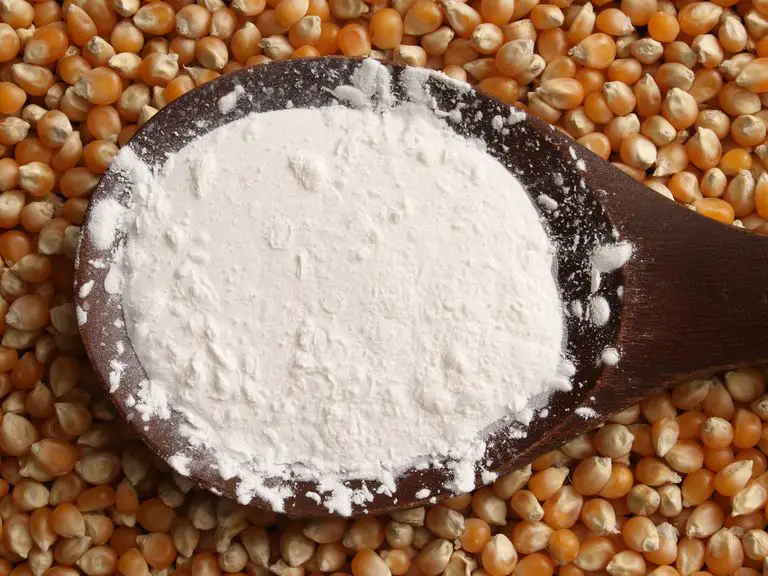
If you’re baking or cooking and realize with horror that you don’t have any cornstarch in your cupboards, fear not. Try out one of these 8 cornstarch substitutes. Read on for all the details you need to know.
10 Cornstarch Alternatives to Consider
Here are the top cornstarch substitutes to consider:
- Arrowroot
- Wheat flour
- Potato starch
- Rice flour
- Tapioca
- Ground flaxseeds
- Xanthan gum
- Glucomannan
- Heat reduction
- Pureed vegetables
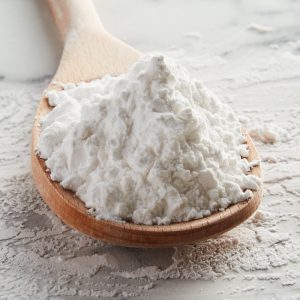
Cornstarch substitutes
#1: Arrowroot
The first option for cornstarch substitute is arrowroot.
Arrowroot is a starchy type of flour made from the roots of the Maranta genus of plants that are found in the tropics.
To make this flour, the roots of the plants are first dried up and then grounded into fine powder, which can also be used as a thickener in cooking.
There are some who lean on arrowroot more than cornstarch because it contains more fiber. When mixed with water, it forms a clear gel and is great for thickening clear fluids.
Experts recommend using arrowroot twice as much as cornstarch to get similar results. It’s also gluten-free, making it suitable for those who don’t eat gluten.
#2: Wheat Flour
Wheat flour is one of our top picks for cornstarch substitutes, especially if you want to thicken gravy, sauces or stews.
It is another suitably nutritious alternative to cornstarch, with fewer carbohydrates, a higher protein content, and more dietary fiber. It also has more minerals and vitamins.
Though it may be more nutritious than cornstarch, wheat flour isn’t as starchy as cornstarch. What this means is that you should use more of it to create the same effect as cornstarch when cooking.
Similar to cornstarch, wheat flour can also makes liquid lumps if one doesn’t mix it properly. So before adding it to foods, try whisking the flour in warm water until it’s even. And be sure to cook flour fully before consuming it.
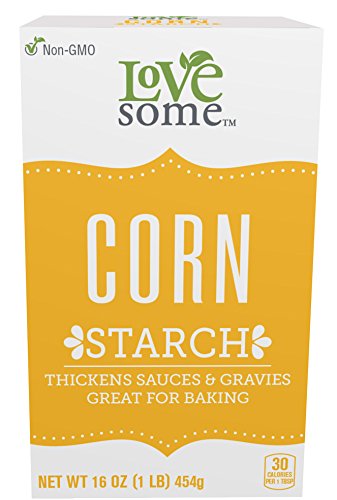 14 ReviewsLoveSome Corn Starch, 16 Ounce
14 ReviewsLoveSome Corn Starch, 16 Ounce
- 100% corn starch
- Multi purpose cooking
- Great for thickening
$2.25 Buy on Amazon
#3 Cornstarch Alternative: Potato Starch
Next up for cornstarch substitutes is the popular potato starch.
As the name suggests, potato starch is a powder that’s made by extracting starch from potatoes and then drying it out.
Potato starch contains a couple of nutrients, but it also contains significantly lesser calories and carbohydrates than cornstarch, which makes it a good substitute for those who are looking to thicken foods without adding extra carbs and calories.
Potato starch is relatively flavorless, which means that it won’t alter or overpower other flavors in foods. And because potatoes are naturally gluten-free, making them a great option for people who are on a gluten-free diet or those with celiac disease.
It’s best to add potato starch later in the cooking process because if the starches overheat, they could break down and lose their thickening qualities.
#4: Rice Flour
Rice flour, made from ground rice, contains a high level of nutrients and is used in many Asian dishes including soups, noodles, and desserts. If of course, is made from ground rice.
It also has more dietary fiber and protein than cornstarch and contains fewer carbohydrates. Rice flour is best used in cold or hot water until it’s even before adding it to food to prevent it from creating lumps.
#5 Cornstarch Substitues: Tapioca
Tapioca is a processed starch product that’s extracted from cassava, a root vegetable found all over South America. It’s made by grinding cassava roots to a pulp that filters out their starch-rich liquid and is then dried into tapioca flour.
However, some cassava plants contain cyanide, which is why it’s important to treat it first to ensure it’s safe. Tapioca can be bought as flour, flakes or pearls and is also gluten-free. Many cooks recommend replacing 1 tablespoon of cornstarch with two tablespoons of tapioca flour. This is one of the most popular alternatives for baking.
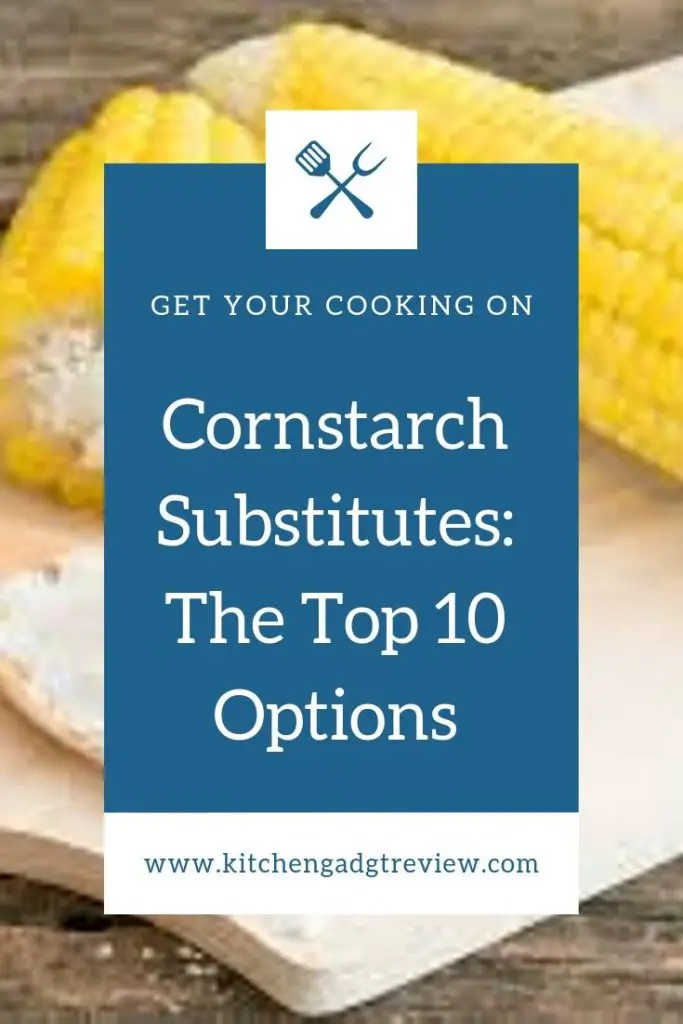
Cornstarch Alternatives
#6 Replacement for Corn Starch: Ground Flaxseeds
Ground flaxseeds are very absorbent and when mixed with water, form a jelly. But unlike cornstarch, which is smooth, the consistency of flax can be a bit gritty.
With that being said, flaxseeds are an excellent source of soluble fiber. That’s why using ground flaxseeds instead of flour can enhance the fiber content of your dish.
For thickening a dish, you can substitute 2 tablespoons of cornstarch by mixing 1 tablespoon of ground flaxseeds with 4 tablespoons of water for similar results. This is one of our top picks for substitutes for baking.
#7: Xanthan Gum
Xanthan gum is a vegetable gum that’s created by fermenting sugar with a bacteria known as Xanthomonas campestris. This will produce a gel that is then dried and turned into a powder that you can use in your cooking. Very tiny amounts of xanthan gum can help thicken a liquid by a large amount.
It’s worth noting, however, that xanthan gum may cause digestive issues for some people if or when consumed in large amounts. Though you’re unlikely to consume that much when using it as a thickener.
You recommended to use a small amount of xanthan gum and add it slowly. You need to be careful, however, not to use too much of it as the liquid could become a bit slimy.
#8: Glucomannan
Last but not least on our list of cornstarch substitutes is Glucomannan.
Glucomannan is a soluble powdered fiber that’s derived from the contents of the konjac plant. It’s very absorbent and forms a thick, odorless and colorless gel when mixed with hot water.
Because glucomannan is pure fiber, it doesn’t contain any calories or carbs, making it a popular substitute for cornstarch for those who follow a low-carb diet. It’s also a probiotic, as in, it feeds the good bacteria in your large intestine and helps you maintain a healthy gut.
Moreover, a recent review revealed that consuming 3 grams of glucomannan a day could reduce your “bad” LDL cholesterol by up to 10%. Also, you’re unlikely to consume that much of it when using it as a thickener. This is because the thickening powder is much stronger than cornstarch, allowing you to use much less.
#9 Cornstarch Substitutes: Heat Reduction
If you’re making a sauce of some kind, good old evaporation can do the trick just as well as adding something like flour or corn starch. The key is patience though! This method will take some time, and be sure to remove the lid from the pot so that the steam can evaporate.
#10: Pureed Vegetables
If you want to kick your healthy eating to the next level, then try thickening gravies, soups, casseroles, or stews with pureed vegetables. They contain a ton of fiber, antioxidants, vitamins and minerals.
Which ones you choose will depend strongly on what kind of dish you’re cooking. But, you can boil things like cauliflower, pumpkin, potato, zucchini, or squash until soft. Then, puree them in a blender or use a potato masher.
Learn More about Cornstarch
Do you want to find out more about this popular thickening agent in cooking, or popular ingredient in deep frying? Then check out this short video below for all the details you need to know:
What is Cornstarch and is it Healthy?
Cornstarch, which is sometimes referred to as corn flour, is a white powdery thickener that’s made from corn as the name suggests. To be more elaborate, it’s made by milling the endosperm of corn, resulting in the creation of a powder with a flour-like consistency.
It’s a very common ingredient that’s found in almost any supermarket and online stores and is widely used in cooking and baking to help thicken, blend and stabilize foods. It is one of the most versatile cooking and baking ingredients and you can find it in a ton of things.
What are the Most Popular Ways to Use Cornstarch?
If you’re wondering when you might use this common ingredient, here are three of the most popular uses:
As a Thickener
You can find this thickening agents in all kinds of things from sauces to gravies and even yogurt. It has twice the thickening power than flour does and it’s also clear rather than opaque. Plus, it has no noticeable flavouring to it.
For Baked Goods
One of the benefits of this product derived from corn is that it’s gluten free. Plus, it can give baked goods more structure, helping them seem fuller and increasing their moisture content.
In Fried Foods
You can sometimes find this ingredient added to batter for fried foods to give them a light and crispy texture.
Is Cornstarch Healthy?
However, this popular ingredient mostly contains starch that’s very high in carbohydrates and calories (30 calories/tablespoon) and has little nutritional content. It doesn’t have any fat, protein, vitamins or minerals. It’s also not a good option for those who wish to lower or regulate their blood sugar or cholesterol levels.
For this reason, rice flour, wheat flour, flax seeds and xanthan gum are considered better nutritional alternatives. Along with similar amounts of calories, they have more nutritional value in terms of vitamins and minerals.
That said, do you ever eat Wonder Bread or white rice? These products are much the same in that they are pure carbs with no other nutritional benefits. And perhaps in small quantities, they are fine to eat as long a you’re not on a restricted diet plan of some kind.
The Best Cornstarch Alternatives
If you’re looking for even more ideas for what you can use in place of Corn Starch, be sure to check out this short video below for all the details you need to know:
How Can I Thicken Without Cornstarch?
You can thicken soups, stews or sauces without cornstarch. You can make a flour slurry of equal parts water and flour by mixing it until it’s smooth and then gradually adding it in while stirring vigorously. You may also consider a roux blend, egg yolks, reducing liquid by boiling, adding pureed almonds or cashews, or using arrowroot.
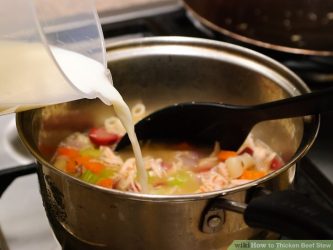
Thickening sauces and stews without cornstarch
Which is Better: Cornstarch or Flour?
If you want to thicken something with starches, two popular options are flour and cornstarch. In terms of thickening power, cornstarch is better and you’ll have to use twice as much flour to achieve the same effect. Either one works well though, but cornstarch does have the advantage of being gluten free for people on restricted diets.
Can I Use Baking Powder or Baking Soda Instead of Cornstarch
It’s not recommended to use baking powder or baking soda as a substitute for cornstarch. Baking soda adds a particular flavour and both of them have specific chemical properties which is why they act as leavening agents. To use them in soups or sauces may not yield the results you want. A better alternative is a mixture of flour and water.
Can Eating Cornstarch Kill You?
Eating raw cornstarch won’t kill you but it may make your stomach upset and cause gas and bloating. It doesn’t add any nutrition to your diet either as it lacks fibre, vitamins and minerals. However, raw cornstarch won’t raise blood glucose levels as quickly as cooked cornstarch will.
What about Baking Powder, Cream of Tartar, or Butter Substitutes?
Did you know that there are lot of baking powder, and cream of tartar alternatives as well? You can check out some of our top picks here: Baking Powder Substitutes and Cream of Tartar Alternatives.
As fas as butter goes, if you’re looking to eat a bit healthier, you may want to consider one of these oils, applesauce, or yogurt for your cooking and baking. You can learn more here: 6 Healthy Butter Alternatives.
Or, you might want to check out these Dijon Mustard Alternatives for the next time you’re making a salad dressing or sandwich.
Have your Say about these Cornstarch Substitutes
What are your thoughts about these cornstarch alternatives? Do you have any additional ones to add to the list. Leave a comment below and let us know what you think. We’d love to hear from you.
Also be sure to give this article a share on Facebook, Twitter, or Pinterest. It’ll help other home cooking enthusiasts, like yourself find this useful resource.
Information contained on this page is provided by an independent third-party content provider. Frankly and this Site make no warranties or representations in connection therewith. If you are affiliated with this page and would like it removed please contact pressreleases@franklymedia.com
More Like This
December 2nd, 2019
April 28th, 2025
April 28th, 2025
Top Headlines
April 28th, 2025
April 28th, 2025
April 28th, 2025








